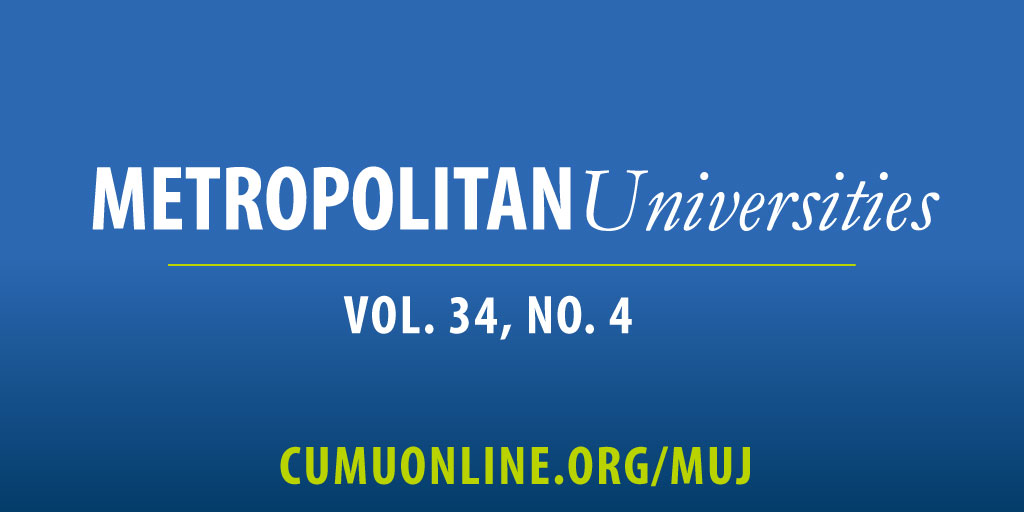Promoting service-learning through an interdisciplinary and decentralized faculty fellows program
Keywords:
service learning, community-based learning, faculty fellows program (FFP), case studyAbstract
The adoption of service and community-based learning can be a challenge across campus. Some units or departments might embrace the approach while others believe it can’t be done in their discipline. Despite being shown to offer benefits for learning and retention, recruiting faculty participation in service and community-based learning (SL/CBL) can be challenging. This article describes the origination and first two years’ outcomes of a decentralized faculty fellow program (FFP) across six colleges at a metropolitan university. The first cohort of faculty recruited for the FFP were tasked with serving as a resource for fellow college faculty/staff after collaborating with college administration to determine priorities. This paper utilizes the fellows’ end of year reports organized around priorities and goals, activities planned or undertaken, and the fellow’s personal reflection of the year to conduct a qualitative analysis. Results show the FFP allowed an individualized approach to address goals, determine tactics, and achieve outcomes across college units and offers opportunity for implementation at any university because of its decentralized structure and ability to adjust to the needs of any specific college or unit.
References
References
Anderson, J. & Pickeral, T. (2000). Challenges and strategies for success with service-learning in preservice teacher education. National Society for Experiential Education Quarterly, 25(3), 7-22.
Billig, S. H. (2000). The impacts of service-learning on youth, schools and communities: Research on K-12 school-based service-learning, 1990 to 1999. Retrieved from https://digitalcommons.unomaha.edu/cgi/viewcontent.cgi?article=1088&context=slcestgen
Bowen, G. A., & Kiser, P. M. (2009). Promoting innovative pedagogy and engagement through service-learning faculty fellows programs. Journal of Higher Education Outreach and Engagement, 13(1), 27-44.
Bringle, R. G., Hatcher, J. A. & Muthiah, R. N. (2010). The role of service-learning on the retention of first-year students to second year. Michigan Journal of Community Service Learning, 16(2), 38-49.
Cazzell, M., Theriot, S., Blakey, J. M., & Sattler, M. L. (2014). Transformation of, in, and by learning in a service-learning faculty fellows program.
Dierberger, J. (2015). P-16 service-learning partnerships: A model for success. In Delano-Oriaran, B., Penick-Parks, M. W. & S. Fondrie (Eds.), The SAGE Sourcebook of service-learning and civic engagement. (p. 171-178). Thousand Oaks, CA: SAGE Publications, Inc.
Dierberger, J. (2021). Motivational and persistence factors for higher education faculty members who collaborate with P-12 teachers to teach P-16 service-learning courses: A constructivist grounded theory. [Unpublished doctoral dissertation]. University of Nebraska, Lincoln.
Drinkard, A. & Tontodonato, P. (2019). The value-added nature of service-learning. Journal of Criminal Justice Education, 30(1), 136-155. DOI: 10.1080/10511253.2018.1446544.
Eyler, J. (2009). The power of experiential education. Liberal Education, 95(4), pp. 24-31.
Gelmon, S. B., Holland, B. A. & Spring, A. (2018). Assessing service-learning and civic engagement: Principles and techniques (2nd Ed.). Boston, MA: Campus Compact.
Kuh, G. D. (2008). High-impact educational practices: What they are, who has access to them, and why they matter. Washington, DC: Association of American Colleges and Universities.
Leach, M., & Bacon, N. (1999). Service learning academy (Memorandum). Omaha, NE: University of Nebraska at Omaha.
Mitchell, T & Rost-Banik, C (2020). Service-learning cohorts as critical communities. Educational Studies, 46:3, 352-367
O’Meara, K., Terosky, A. L. & Neumann, A. (2008). Faculty careers and work lives. ASHE higher education report, 34(3), 1-23.
Russell-Stamp, Melinda. “Faculty Use of Community-Based Learning: What Factors Really Matter?” Michigan journal of community service learning 21, no. 2 (2015): 37–.
SRI International. (2007). Investing in Omaha’s children & youth: Master plan. Building Bright Futures.
Wade, A. & Demb, A. (2009). A conceptual model to explore faculty community engagement. Michigan Journal of Community Service Learning, 15(2), 5-16
Warren, J. L. (2012). Does service-learning increase student learning? A meta-analysis. Michigan Journal of Community Service-Learning, 18(2), 56-61.
Weerts, D. J. (2007). Facilitating university engagement with schools. Metropolitan Universities Journal, 18(4), 67-86.
Werder, C., Harwood, A., Ochs, L., Currier, D., Duke, S., Hammond, J. D., ... & Stout, K. (2005). Communities for growth: Cultivating and sustaining service-learning teaching and scholarship in a faculty fellows program. Michigan Journal of Community Service Learning, 41.
Downloads
Published
Issue
Section
License
Copyright (c) 2023 Shannon Cummins, Mitzi Ritzman, C. Cecilia Tocaimaza-Hatch, Jodi Benenson, Andrea M. M. Weare

This work is licensed under a Creative Commons Attribution 4.0 International License.



